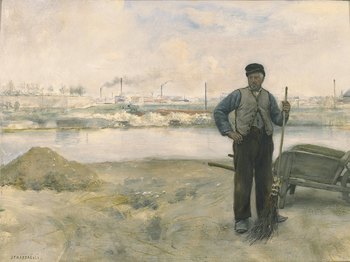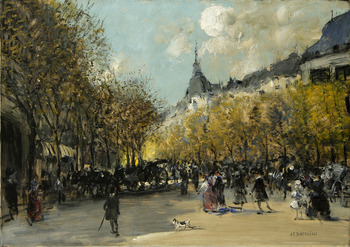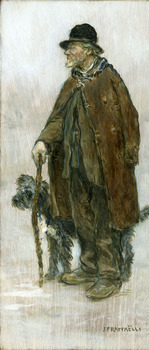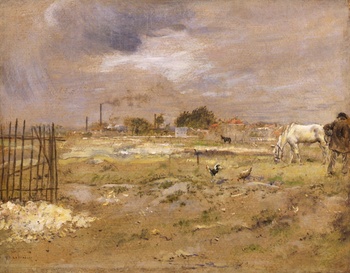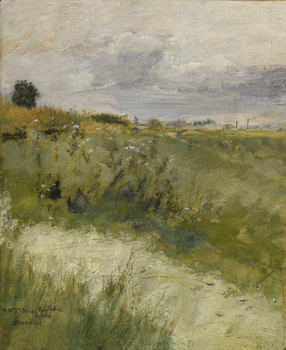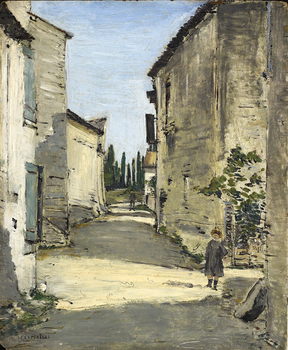Jean-François Raffaëlli
An artist who treaded the line between various styles of painting and who created an oeuvre diverse in both subject and style, Jean François Raffaëlli typifies the aesthetic and political concerns of his time. An advocate of a philosophical art that reflected modern sociological conditions, the majority of Raffaëlli?s work surrounds the new, modern city of Paris. Throughout the course of his career, he focused his attention on the downtrodden rag-pickers and wanderers living on the fringes of society, on the growing suburbs of Paris, and on the vibrant street life of the city. His works display both the bustling city and a segment of humanity hidden from public view and largely overlooked by other artists, thereby portraying Paris from many faceted views. He combined his sensitivity for the subject with an acute perception of his environment, a strong tendency to draftsmanship, and the light, painterly touch of the Impressionists.
A Naturalist painter in his concern with photographic verisimilitude and the portrayal of psychological character, and an Impressionist by his association with the group, Raffaëlli?s work defies definite categorization. Raffaëlli began his Salon career in 1870 when one of his landscape paintings was accepted despite his lack of formal training. In 1871, he enrolled at the École des Beaux-Arts and entered the studio of Gérôme. Dissatisfied with a lack of rigor at the École, Raffaëlli left after only three months and pursued his studies in the galleries of the Louvre and Luxembourg Museums where the works of Corot, Gérôme and Fortuny became his masters. While he continued to show regularly at the Salon until his death in 1924, Raffaëlli did not disregard alternate groups: he exhibited with the Impressionists in 1880 and 1881.
Raffaëlli began his career working from a studio in the Parisian suburb of Asnière and painting those pushed outside of Paris during reconstruction of the city. In 1892, he relocated to a studio on the rue de Courcelles in Paris and began to paint colorful views of the streets, squares and parks of Paris. He said of this transition,
I work according to the humor of the moment?Today I am an optimist, and my paintings that you can see on the Champ-de-Mars are joyful. I have fallen in love with light!...My mode of working, I repeat, follows the whims of my humor and I think it must be so. 1
Given Raffaëlli?s conviction that art played a sociological role through its analysis of the character of modern life, his new focus, in the 1890s and after, on the joyousness of Paris?s street life is revealing. 2
By the time Rafaelli died in 1924 his fame had spread across the Atlantic, where he held exhibitions in New York, Boston and Philadelphia as early as 1895.
Selected Museum Collections:
Musée d?Orsay and Musée du Petit-Palais, Paris; Metropolitan Museum of Art, New York; Musée départemental de l?Oise, Beauvais; Musée Bonnat, Bayonne; Musée des Beaux-Arts de Bordeaux; Museum of Fine Arts, Boston; Brooklyn Museum of Art; Museo Nacional de Bellas Artes, Buenos Aires; Fogg Museum, Harvard Art Museums, Cambridge, MA; Art Institute of Chicago; Cleveland Museum of Art; Finnish National Gallery of Art, Helsinki; Indianapolis Muesum of Art; Musée Louis Senlecq, L?Isle Adam; Musée de l?Ancien Evêché, Evreux; Musée des Beaux-Arts de Lille; Los Angeles County Museum of Art; Musée des Beaux-Arts de Lyon; Musée des Deux-Victoires, Mouilleron-en-Pareds; Musée des Beaux-Arts de Nantes; Musée des Beaux-Arts de Pau; Philadelphia Museum of Art; Musée des Beaux-Arts de Rouen; Musée d?art, d?archéologie et de sciences naturelles, Troyes; Stichting van Baaren Museum, Utrecht; Musée de la Princerie, Verdun; Musée national des châteaux de Versailles et de Trianon, Versailles; National Gallery of Art, Washington, DC;
1 Cited by Puech, ?Raffaëlli, champ-de-Mars,? Le Figaro, 27 May 1896; rpt. Marianne Delafond and Caroline Genet-Bondeville, Jean François Raffaëlli (Paris: Musée Marmottan-Monet, 1999): p. 49.
2 For more information see Gabriel Weisberg, The Realist Tradition (Cleveland: Cleveland Museum of Art, 1980): p. 307.

